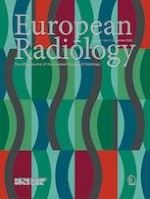Published in:

01-11-2020 | Magnetic Resonance Imaging | Magnetic Resonance
Evaluation of liver iron overload with R2* relaxometry with versus without fat suppression: both are clinically accurate but there are differences
Authors:
M. Plaikner, C. Kremser, H. Zoller, W. Jaschke, M. Steurer, A. Viveiros, B. Henninger
Published in:
European Radiology
|
Issue 11/2020
Login to get access
Abstract
Objectives
To assess clinically relevant difference in hepatic iron quantification using R2* relaxometry with (FS) and without (non-FS) fat saturation for the evaluation of patients with suspected hepatic iron overload.
Methods
We prospectively enrolled 134 patients who underwent 1.5-T MRI R2* relaxometry with FS and non-FS gradient echo sequences (12 echoes, initial TE = 0.99 ms). Proton density fat fraction for the quantification of steatosis was assessed. Linear regression analyses and Bland-Altman plots including Lin’s concordance correlation coefficient were performed for correlation of FS R2* with non-FS R2*. Patients were grouped into 4 severity classes of iron overload (EASL based), and agreement was evaluated by contingency tables and the proportion of overall agreement.
Results
A total of 41.8% of patients showed hepatic iron overload; 67.9% had concomitant steatosis; and 58.2% revealed no iron overload of whom 60.3% had steatosis. The mean R2* value for all FS data was 102.86 1/s, for non-FS 108.16 1/s. Linear regression resulted in an R-squared value of 0.99 (p < 0.001); Bland-Altman plot showed a mean R2* difference of 5.26 1/s (SD 17.82). The concordance correlation coefficient was only slightly lower for patients with steatosis compared with non-steatosis (0.988 vs. 0.993). The overall agreement between FS and non-FS R2* measurements was 94.8% using either method to classify patients according to severity of iron storage. No correlation between R2* and proton density fat fraction was found for both methods.
Conclusion
R2* relaxometry showed an excellent overall agreement between FS and non-FS acquisition. Both variants can therefore be used in daily routine. However, clinically relevant differences might result when switching between the two methods or during patient follow-up, when fat content changes over time. We therefore recommend choosing a method and keeping it straight in the context of follow-up examinations.
Key Points
• Both variants of R2* relaxometry (FS and non-FS) may be used in daily routine.
• Clinically relevant differences might result when switching between the two methods or during patient follow-up, when fat content changes over time.
• It seems advisable choosing one method and keeping it straight in the context of follow-up examinations.





